Everyone loves to read about the latest growth hack like there's a secret steroid that will make any company grow rampantly. But, as HubSpot's former VP of Growth, Brian Balfour, observes, there isn't any single tactic that will grow every company.
Different companies have different audiences, different products, different customer lifecycles, and different business plans—there's no reason to assume that a tactic that works well with one audience will work well with a different audience.
What you need for consistent growth is a system for methodically running and iterating on a variety of growth experiments. By developing and testing hypotheses on what drives growth for your specific pieces, you can develop a growth strategy that's sustained over time, instead of trying to catch lightning in a bottle with a single growth hack.
Build a machine for sustained growth
If you jump head-first into the experimentation process, chances are good that you'll get lost in a sea of data that doesn't actually show you the way to chart a course for perpetual growth in the future. That's why Balfour's team embeds their experimentation process in a broad growth machine: a scalable, predictable, and repeatable process to generate high-impact growth tactics.
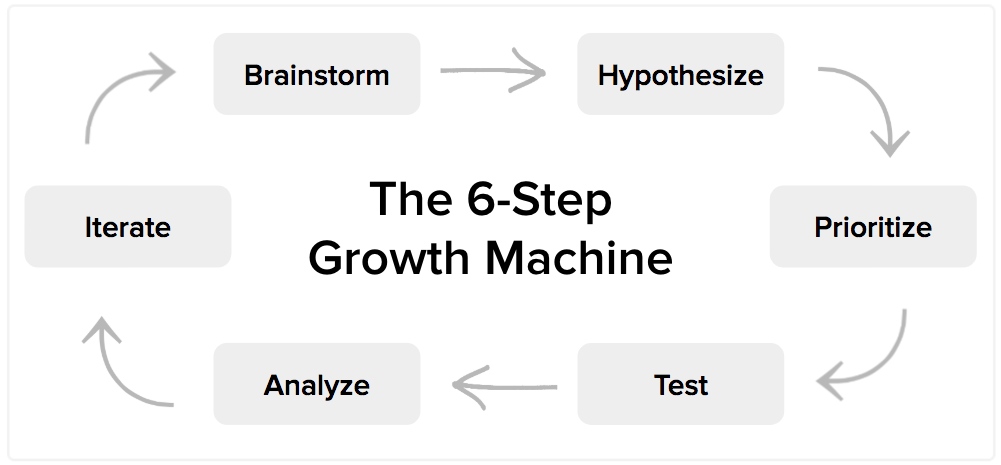
You can use the following 6-step framework to build your own sustainable growth machine.
- Brainstorm. Create a living index of all your ideas, big and small, for how to grow your company.
- Hypothesize. Use your existing data from previous experiments to make an educated guess of how much growth each of your brainstormed ideas would drive.
- Prioritize. Determine which of your ideas offer the best ratio of potential growth to resources required to implement.
- Test. Run experiments to test out your highest-growth experiments.
- Analyze. Learn from your experiment's results: see whether the test supports your hypothesis, and figure out why it does or doesn't.
- Iterate. Brainstorm followup experiments that you could run to better understand the results of your last experiments—and feed those followup ideas back into step 1 of this framework.
Instead of reinventing the wheel every time you run an experiment, you can use this machine to ensure that every experiment is in service of your broader growth mission.
1. Brainstorm
The growth machine starts by reframing how you think about ideas for growth. Instead of coming up with a single idea to test during your next sprint, start cataloging every idea, big and small, that occurs to you as a way to grow your company.
Focus your brainstorming by focusing on your current strategic objectives. Balfour recommends using the Objectives and Key Results framework (OKRs) to keep all of your company's teams oriented around a simple and transparent set of growth goals.

With your OKRs in mind, start developing a repository of growth ideas that could help you achieve the results you're aiming for. Create a pipeline so that you can track how each idea is developing—"Brainstorm," "Planning," "Testing," "Analyzing," and "Complete."
Identify ideas as being in the "Brainstorm" process at the beginning, then move them through the pipeline as you decide which ideas to actually execute on.

This method ensures that you gradually build up a deep well of growth possibilities. Treating this well as your raw inspiration, you'll then be able to procedurally determine which of your many ideas have the highest potential return on investment.
2. Hypothesize
To judge the potential impact of your ideas, you'll need to formulate clear, falsifiable hypotheses about how much your proposed change would alter which key growth metrics.
Maybe you're thinking about adding a CTA for free trial signups to the end of all the videos on your company's website. You might hypothesize that adding this CTA will increase free trial signups.
But for the growth machine to function well, you need to be able to discern the impact of your experiments with numerical precision. A better hypothesis would be that adding the CTA will increase free trial sign-ups by 5 percent—a specific numerical value.
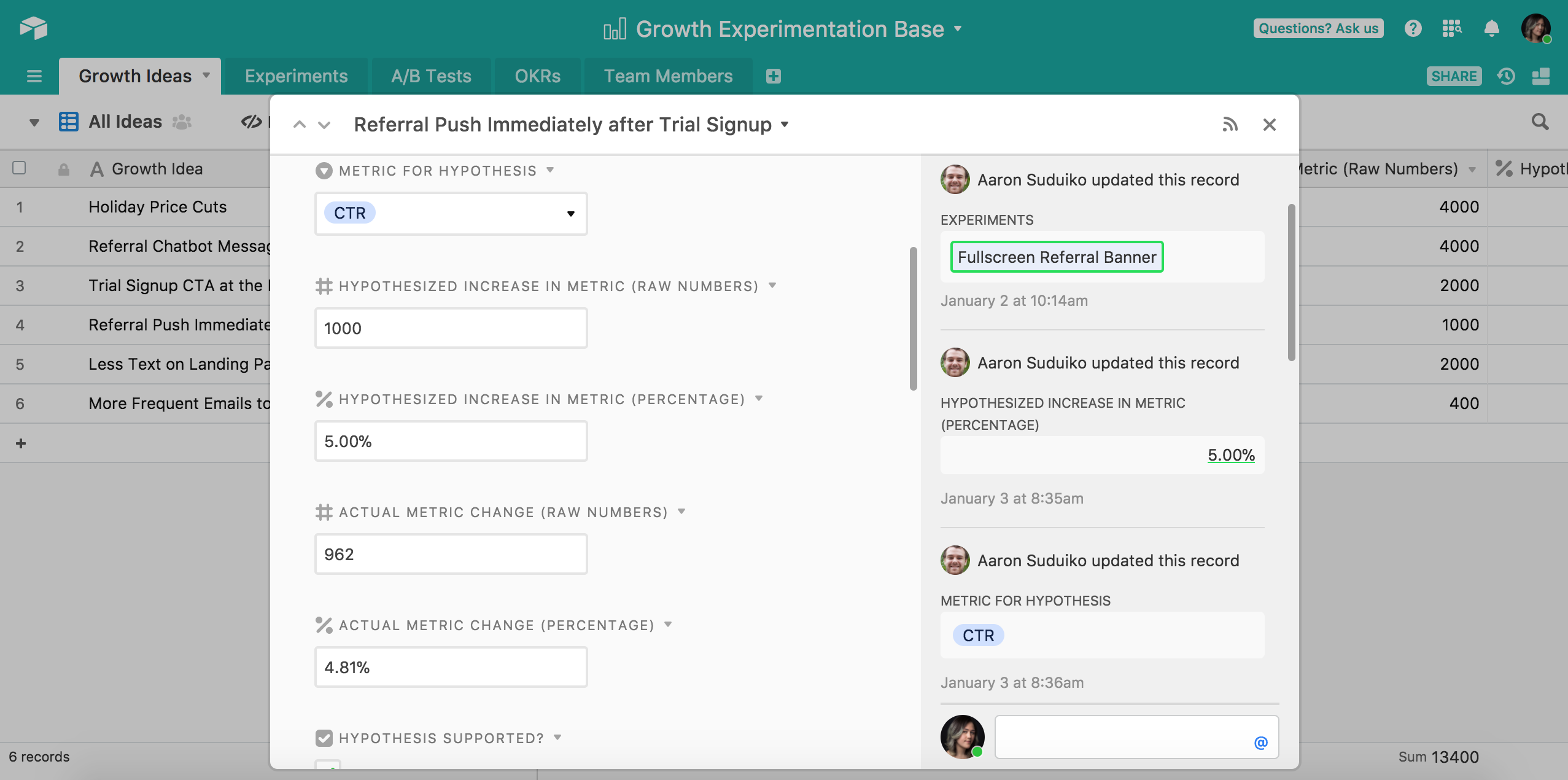
You can develop your hypotheses based on research, comparisons to comparable companies—or, most importantly, you can use results from your previous growth experiments to inform your expectations of how upcoming experiments will turn out.
3. Prioritize
Prioritization is the stage where you ask the question: "What is the one thing we can achieve in order to drive the biggest impact on our growth curve right now?"
By now, you already have a wealth of brainstormed ideas on how to meet your OKRs, along with hypotheses about how much they'll impact your metrics. Add an estimation of how many hours each team will need to spend in order to execute each of your ideas—the marketing team, the engineering team, and the design team.
With this data in hand, you can evaluate which of your ideas, at any given time, offer the highest return on investment.
Just identify those ideas with the largest ratio of impact (as measured by your quantitative hypothesis) to resources invested (as measured by team hours).
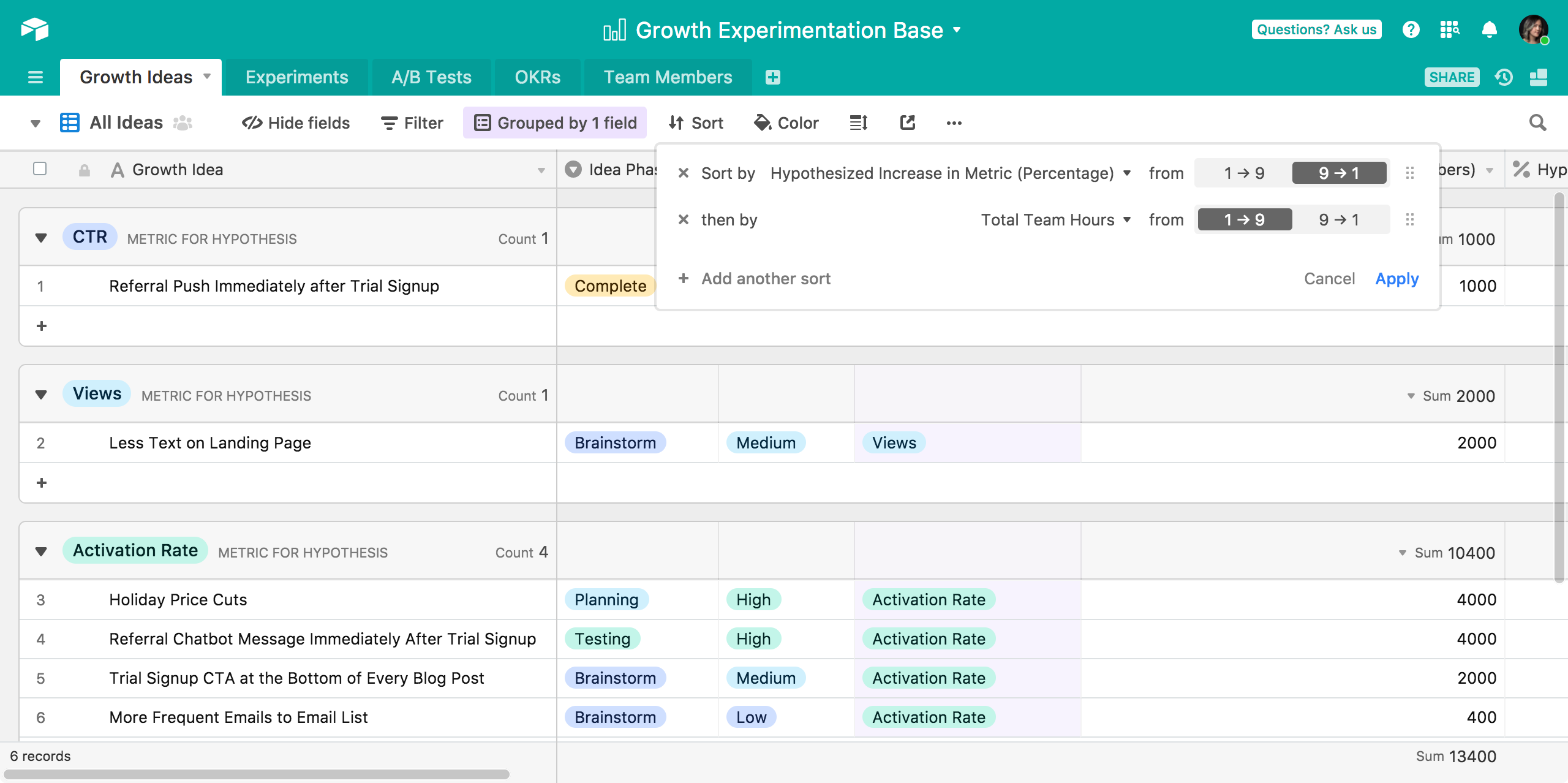
Not all experiments are created equal, and there are only so many hours in the day. Systematic prioritization guards your time against low-impact, resource-intensive experiments.
4. Test
Only once you've identified the experiment you ought to prioritize do you actually run the experiment. With the setup you've done, it should be straightforward to wrangle your teams and test out your idea.
Any idea you have can be tested with multiple experiments and A/B tests. Maybe you want to increase signups by prompting users to refer friends immediately after purchasing your product. There's a variety of ways to test that: you could add a fullscreen referral banner after the checkout page, or you could add a chatbot to recommend that new users refer their friends.
By keeping an unambiguous record of which ideas spawned which experiments and tests, you get a fuller picture of exactly which ideas are contributing to growth and how you can use them to make educated guesses about further sources of future growth.
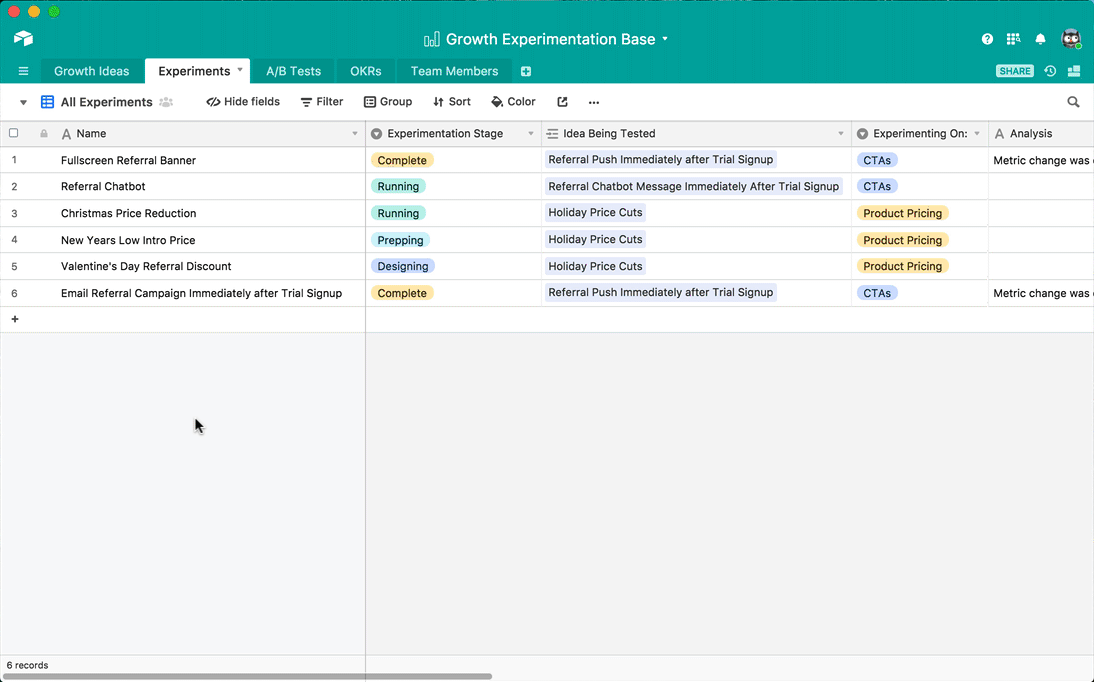
Be sure to carefully track the metric you used in your hypothesis—but also track more growth metrics if you can, in case there are interesting results in other, unexpected dimensions of growth.
5. Analyze
When you're analyzing the results of your experiment, focus on how you can feed your findings back into your growth process machine to fuel future experiments.
More importantly, see whether your findings support your hypothesis: if they do, then you can conduct experiments to further test that same hypothesis, and if they don't, then you can run more tests to figure out where you went wrong in your thinking.

Keep an eye out for unexpected impacts that the experiment had on growth—maybe it affected a metric you weren't initially interested in, or maybe your engineering team ended up building something for your test that you could repurpose for other growth purposes (something like a chatbot for your website). These unexpected impacts are the seeds for new ideas to feed directly into your next brainstorm.
6. Iterate
The end of an experiment is an opportunity for a follow-up experiment. Your growth machine is sustainable in the long-run because once you've begun running experiments, your future experiments can be informed by your concrete findings from past growth tests.
To make sure this happens, you should be meeting regularly to debrief. Once a week (or at whichever cadence you choose for your growth team), you should discuss the results of the experiments from the preceding week.
That means checking in on your progress towards your various OKRs, the status of any ongoing A/B tests, and what members of the team have learned from concluded experiments.
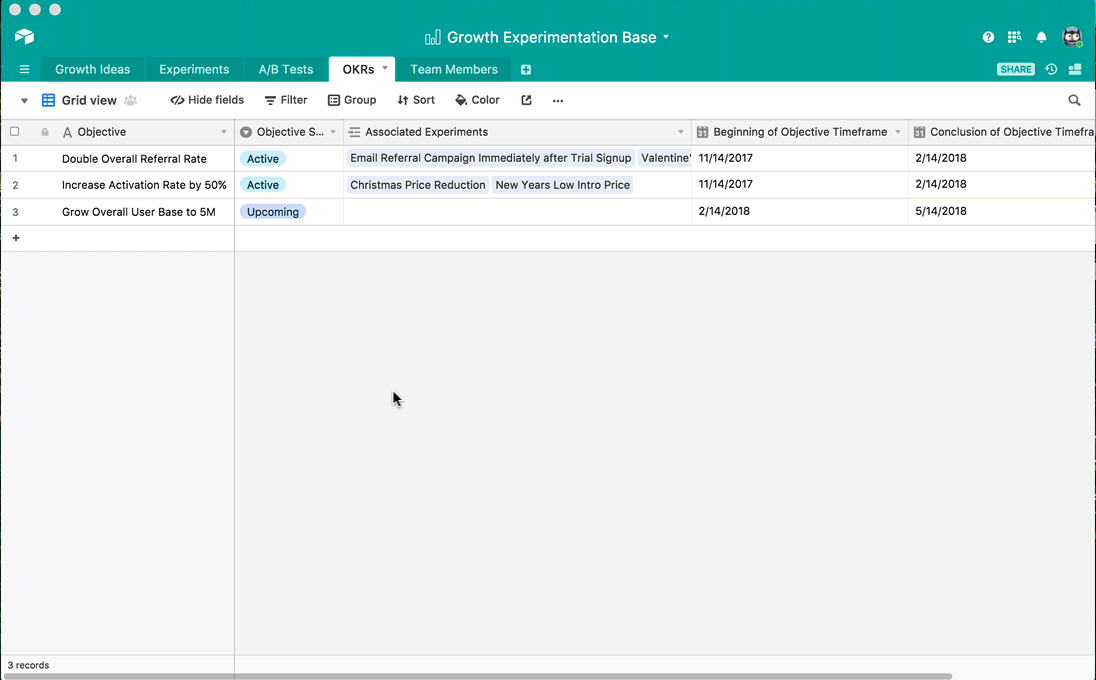
Successful experiments can be doubled down upon. Did your CTA at the end of your video end up driving more sign-ups than expected? Consider running an experiment where you add CTAs to more media, like the end of your blog posts.
Unsuccessful experiments can be framed as learning experiences.
The key thing is that you're easily able to perform the kind of reflexive zooming in and zooming out that you need to do in order to maintain perspective on what you're doing. Your individual experiments matter because of the goals that they're going to help you to meet—if they're "succeeding" but nothing is changing, you have a problem.
Continued growth is all about iterating, and treating every experiment as a learning opportunity.
Make growth a science, not a guessing game
With a centralized system in place, you'll be empowered to make small advances in growth repeatedly over long periods of time—with compounding interest. As you learn which experiments are succeeding, you can invest your resources more smartly into experiments that better target the true drivers of your company's growth.
The only honest growth hack is disciplined, systematic research—and the longer you keep at it, the faster you'll grow.